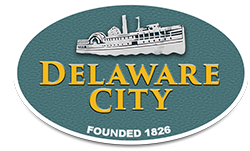There are three styles associated with the Romantic Revival in Delaware City: Italianate, Gothic Revival, and Second Empire. The Italianate and Gothic Revival styles were developed as part of the Picturesque movement. Formal, classical ideals expressed by Federal and Greek Revival styles lost popularity in favor of styles that were inspired by rural, naturalistic forms. The Second Empire was very fashionable during the mid-nineteenth century, and was often used form for new construction and the remodeling of older buildings. Almost two-thirds of the commercial buildings in Delaware City were constructed during the years between 1850 and 1900. Many of these buildings are of mixed styles, with the Italianate style tying with Greek Revival as the most frequently occurring style. There is only one building with Gothic Revival characteristics; out of three that exhibited Second Empire details, only two survive.
ITALIANATE
Typically two or three stories in height, Italianate buildings in Delaware City’s Commercial District have low-pitched roofs and deep overhanging eaves with decorative brackets. The proportions of both the overall building and the windows on the facades are tall and rectangular. Tall narrow windows are the only identifying feature for the buildings such as 72-74 Clinton Street, which as seen in historic photographs, lacks stylistic features such as a bracketed cornice. Windows in Italianate buildings usually have single pane (one-over-one) or double pane (two-over-two) double-hung sashes.
There are three examples of the one-part block Italianate style in Delaware City 52, 38, and 96 Clinton Street. 52 Clinton and 96 Clinton feature side-gabbed roofs with very low-pitched roofs. 38 Clinton is the only example of a gable-front building on the street. Although 96 Clinton is a one-part block, with no divisions between the lower and upper floors, it is paired with the two-part block building at 98 Clinton Street.
The two-part block Italianate style occurs frequently on Clinton Street. These buildings were constructed between 1850 and 1890, a period when Delaware City experienced heavy growth within the business district. The corner building at 98 Clinton Street is a good example of this composition. A pent roof provides a strong division between the first, storefront level and the upper stories. The rest of the composition is vertical, with tall windows, a deep roof overhang, and decorative brackets. Historically, division between the lower and upper floors was often created by porches or awnings, as seen in the historic photo of 72-74 Clinton Street.
GOTHIC REVIVAL, SECOND EMPIRE, & OTHER STYLES
The building at 34 Clinton Street, with its distinctive gabled roof, is the only example of the Gothic Revival style in Clinton Street Commercial District. The Gothic Revival style was most often applied to rural houses, rather than to urban commercial buildings, and usually featured elaborate rustic detail. However, the oversize front-facing gable above 34 Clinton’s two-part block façade is certainly evocative of that style.
The Second Empire style was represented by the Robinson Hotel at 54 Clinton, which was demolished prior to the construction of the current Delaware City post office. This style was seen as appropriate for both residential and commercial buildings, and was popular for its association with French fashion. The hotel’s mansard roof, also called a dual-pitched hipped roof, was characteristic of this style. The pitch of the roof allowed for a full or half-story to be housed under the roofline. The hotel was built in several different sections and contained many different uses over the years. The upper floor of the façade was consolidated under a mansard-style roof to give the building a more unified and modern appearance. The hipped form was added only to the façade, while the building probably retained its original roof form. Similar mansard-style overhangs were attached to buildings at 70 and 76 Clinton Street.
Only one other building style is represented in the Clinton Street Commercial area. The post office at 54 Clinton, the site of the old Robinson Hotel, is a one-part commercial block in the middle twentieth-century modern commercial style. The low-sling, horizontal configuration of the building and the floor-to ceiling glass windows are all distinctly modern, and present a marked contrast to the older buildings on either side.
